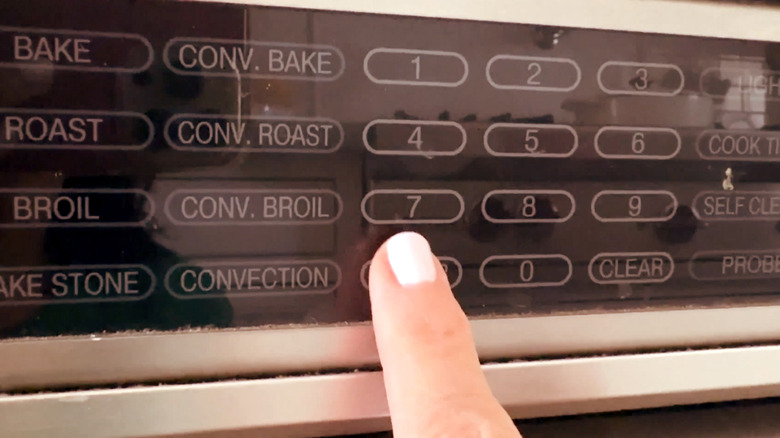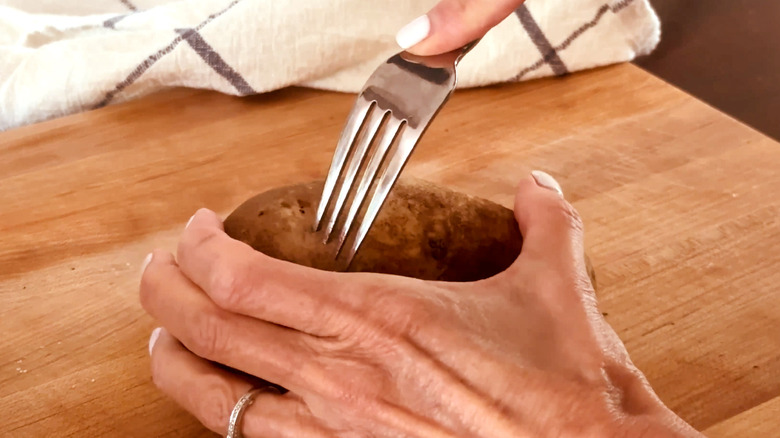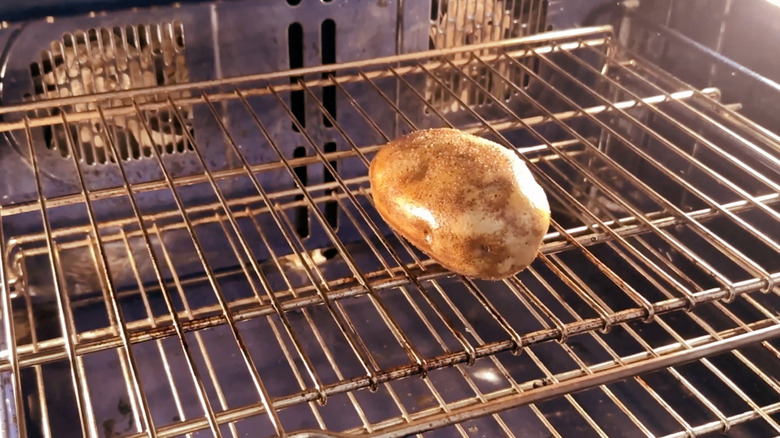You're Doing It All Wrong - How To Make A Baked Potato
Baked potatoes are a filling side dish with a mild flavor that pairs with so many meals; plus, you can customize them however you want with additional toppings. But if you're not a potato expert, you might be missing out on some easy tips, tricks, and techniques to build the perfect baked potato.
Chowhound recipe developer Miriam Hahn offers her advice on the best way to make a baked potato in this "You're Doing It All Wrong" video, and the process starts with the most important element: the type of potato itself. Hahn recommends using russet potatoes. These potatoes are starchy and low in moisture, so they bake well in the oven. Hahn does not advise using waxy potatoes in this case. "You won't get that fluffy inside texture that we get from a russet potato," she says. Russets are the easiest to find, and they're also the most affordable potato variety you'll see in your grocery store.
Aside from the potato type, Hahn says it only takes a few household ingredients to nail this easy side dish: oil, coarse salt, and black pepper. Beyond those basics, making a restaurant-worthy baked potato is all about the technique.
Oven temperature is key for the best baked potatoes
When you start preparing anything that requires oven time, it's best to preheat the oven as step one. Some ovens take a while to get to the right temperature, so preheating allows this step to take place while you do other things. Set the oven temperature to 400 degrees Fahrenheit — be careful not to preheat the oven any lower, or you could ruin the baked potatoes. "Your potato is going to take that much longer to bake, and it will dry out in that extra time," Hahn says of a lower temperature.
Some ovens come with a convection setting, and if you have the option to use it, you should. Convection cooking circulates hot air around the oven as opposed to just cooking from the bottom. "Everything cooks a little more evenly, and even a little bit faster," Hahn says. If you have multiple convection buttons on your oven, you should use the setting meant for baking.
Preparing your potato for the oven
Cleaning the potato is another essential step. Potatoes grow in the ground, so dirt holds tightly onto the skin. Avoid the mistake of a "gritty" potato skin once it's cooked; don't just give these spuds a quick rinse — use a scrub brush to adequately remove any dirt before baking. Dry the potato thoroughly; it shouldn't be wet when it goes into the oven, or it could steam instead of roast.
You also want to poke holes in the potato to avoid that same problem. As potatoes cook, steam builds up, and poking the potato with a fork prior to baking it gives that steam an easy escape route; letting the steam escape keeps the interior fluffy. But make sure to thoroughly stab your potato. "A common mistake people make is just give it a couple pokes on the top and call it good," Hahn says. "But we're going to actually poke it eight to 10 times around the whole circumference of the potato."
Next, it's time to season your potato; Too often people skip seasoning their potatoes before they go in the oven, but that's one of the mistakes that can lead to a bland baked potato. Brush the potato with oil (a high smoke-point oil is best here because of the oven temperature, so Hahn suggests avocado oil), then season the skin generously with salt and pepper. "This will give the skin a really great taste when we're enjoying our potato," Hahn says.
Baking your potato and knowing when it's done
Finally, your potato is ready to go in the oven. Some people feel inclined to wrap their potato in foil, but Hahn advises against it. Instead, place your potato directly on the middle oven rack without foil and set the timer for 45 minutes.
Potatoes cook slowly, so while this is a general rule of thumb, Hahn adds that larger potatoes might take a bit longer. Thankfully, there is an easy way to tell when your potato is done: Carefully remove the potato with tongs, stick a fork in it, and if it comes out easily, that means the inside is tender and fluffy, and the potato is completely cooked. From there, it's all about the toppings. Hahn keeps it simple with butter and chives, but you can also add sour cream, cheese, and even a little bacon.
If you want to prepare the potatoes ahead of time, there are two easy ways to keep them warm: in the warming drawer of your oven or in your slow cooker. "Put them in [the slow cooker], put the lid on, and set the slow cooker to warm," Hahn says. "They'll be perfectly ready for you when you're ready to have dinner." And with common mistakes avoided, it will make a delicious dinner indeed.


